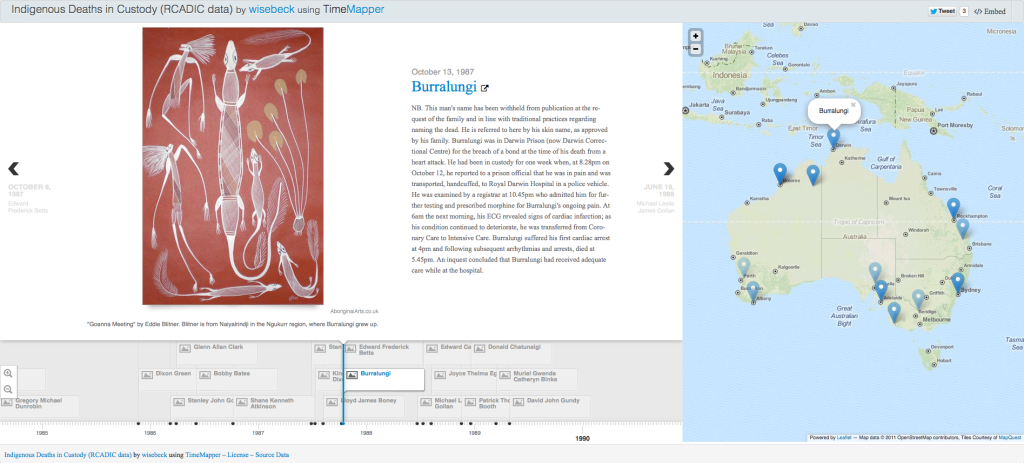In the summer of 2015, I designed a lesson plan using TimeMapper, an open source tool for building timelines in which each event is mapped to its temporal and geographic location, for the Department of Rhetoric & Writing’s First Year Writing course. This course is primarily taught by graduate student instructors in their first year as an instructor of record; they are provided with an ‘Instructor Guide’ which, alongside other resources, contains day plans for each class over the course of the semester. The TimeMapper lesson plan was one of three explicitly digital plans written for the instructor guide.
The lesson plan asks students to work individually or in small groups to create a single class-wide timemap of an issue or event related to the course theme — in 2015-16, Race & Criminal Justice — and is designed for digital classrooms. However, it’s readily adaptable to BYOD classes — since TimeMapper is a web app, it works across platforms — and other course themes. It has already been employed in literature classes in the DWRL, as well as in the FYC classes for which it was designed, and since its publication on the Lab website, I anticipate it will spread further.
The RHE306 instructor guide is circulated in print (in 2015-6; beginning next year, it will be a fully digital publication) but the lesson plan and its accompanying handouts (discussed elsewhere) were composed digitally and it was always intended that they would have a permanent home on the DWRL website. These modes of circulation affected my composing choices. The lesson plan relies on web-based tools and has a number of moving parts, all of which need to be linked to: the TimeMapper tutorial and interface, the source google doc, the sample documents I provided. I used the URL shortener tinyURL to include these links in typeable form, because tinyURL affords you the opportunity to choose your own custom shortened link, rather than a string of random characters. The format of the lesson plan departs from the old DWRL Lesson Plans template, instead following the format established when the first RHE306 instructor guide was composed in summer 2014 (a project I assisted on).
The instructor guide is currently being revised for longevity (it was rewritten in summer 2015 to reflect the new theme, but the next version will be stable for three years) and the lesson plan will be forked as part of that revision, with all references to the 2015-16 course theme being removed and generic content suggestions made instead. These changes will be minimal since the lesson plan was initially written with adaptability in mind: there were already day plans for every single class meeting in the instructor guide, so this lesson was presented as an alternate that could be substituted in at a variety of points in the semester, with a variety of pedagogical goals in mind depending on the instructor’s needs and class’ progress.
That said, the lesson plan does have its own core pedagogical goals which underlie those brought in by instructors adapting the plan. Broadly speaking, it teaches undergraduate students to research the larger context of a given issue or event, articulate the temporal, geographic and other links between events, and present their research in an innovative way. The lesson plan is simultaneously a lesson for instructors, introducing them to a new digital pedagogical tool and offering them best practices for incorporating both new technologies and collaborative composing practices in their classrooms.

